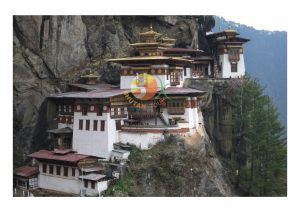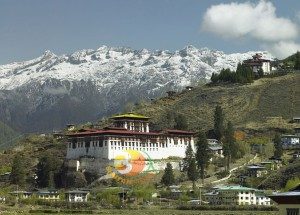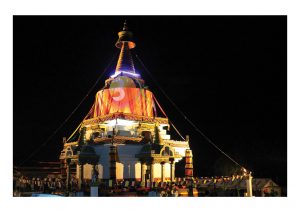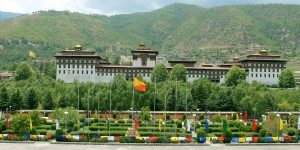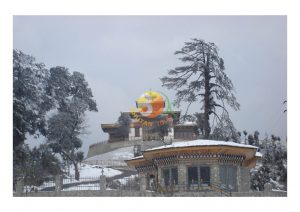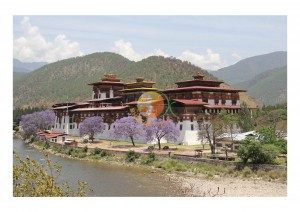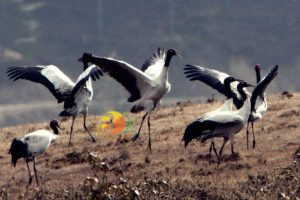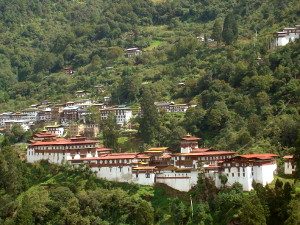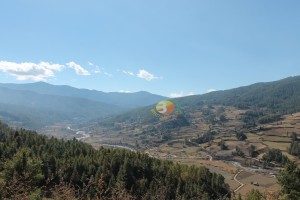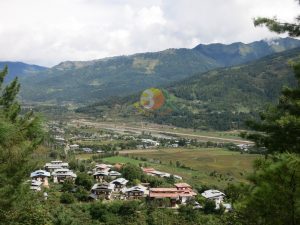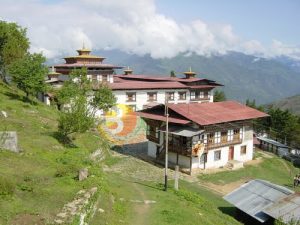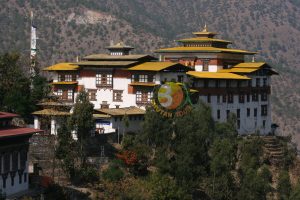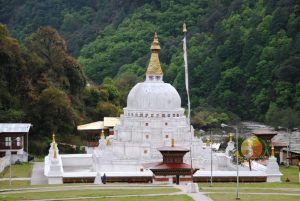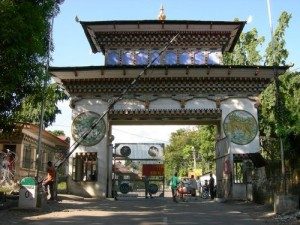- Government Royalty: USD 65 per Person per Night.
- 2% Government Tax per Person per Night.
- All Meals.
- Daily Mineral Water.
- English Language Speaking Guide.
- Comfortable and Luxurious Imported Cars for Internal Transportation with Skilled Driver.
- Entrance fees for Museums.
- The Government set package rates are valid for accommodation on twin sharing basis.
- A minimum of 3 star accommodation (4 & 5 star may require an additional premium).
The Geography of Bhutan is the tiny Kingdom of Bhutan lies hidden in the folds of the eastern Himalayas sandwiched between the two giant countries of India in the south and China in the north. With a total area of 38,398 sq kilometers, approximately the size of Switzerland, Bhutan It is a mountainous country except for a small flat strip in the southern foothills is kwon as last Shangri-La of Himalaya. In the north we border with Tibet, the autonomous region under China, the Indian state of Arunachal Pradesh and in the south with the Indian states of Assam and West Bengal.
Day 1: Arrive Paro
Day 2: Paro
Day 3: Paro – Thimphu (55 km, 2 hours)
Day 4: Thimphu
Day 5: Thimphu – Punakha (75 km, 3 hours)
Day 6: Punakha – Wangduephodrang -Gangtey (Phobjikha) (70 km, 3 hours)
Day 7: Gangtey (Phobjikha) – Trongsa (128 km, 4.1/2 hours)
Day 8: Tongsa – Bumthang (Jakar) (68 km, 3 hours)
Day 9: Bumthang
Day 10: Bumthang – Mongar (198 km, 7 hours)
Day 11: Mongar – Trashigang (96 km, 3 hours)
Day 12: Trashigang (excursion to Trashiyangtse)
Day 13: Trashigang – Samdrup Jongkhar (180 km, 6 hours)
Day 14: Depart Samdrup Jongkhar
Day 01: Arrive Paro
The flight to Paro on a clear day is one of the most spectacular of all mountain flights. One can see Mt. Everest, Kanchenjunga, Makalu and other peaks in Bhutan such as Chomolhari, Jichu Drake and Tsering ghang.
On arrival at Paro airport, received by our representative and transfer to the hotel. Evening take a stroll around Paro market and town. Overnight at the hotel in Paro.
Day 02: Paro
After Breakfast proceeds to Taktsang Palphug Monastery more famous as Paro Taktsang is a Buddhist temple complex which clings to a cliff, 3120 meters above the sea level on the side of the upper Paro valley, Bhutan.
The Taktsang Palphug Monastery is one of the most famous touristic destinations of the country and the cultural icon of Bhutan.
Visiting the Paro Taktsang Monastery is an unforgettable experience thanks to its unique location and the views of surrounding majestic mountains and emerald green valleys.
After lunch, drive up the valley to Drukgyel Dzong, built in 1647 by the Shabdrung to commemorate the Bhutanese victory over the Tibetans in war of 1644.
Day 03: Paro – Thimphu (55 km, 2 hours)
After breakfast Visit to Ta Dzong (National Museum) and then walk down the trail to visit Rinpung Dzong which has a long and fascinating history.
After lunch to Thimphu, the capital town passing via idyllic countryside, through villages and paddy fields. Overnight at the hotel in Thimphu.
Day 04 : Thimphu
Today’s full day of sightseeing in Thimphu valley includes, visit to ;
Memorial Chorten; the beautiful stupa built in the memory of Bhutan’s third King. The paintings and statues inside the monument provide a deep insight into Buddhist philosophy.
Then proceed to Buddha Dordenma is a gigantic Shakyamuni Buddha statue under construction in the mountains of Bhutan. The statue will house over one hundred thousand smaller Buddha statues, each of which, like the Buddha Dordenma itself, the Buddha Dordenma is sited amidst the ruins of Kuensel Phodrang, the palace of Sherab Wangchuck, the thirteenth Desi Druk, overlooking the southern approach to Thimphu, the capital of Bhutan.
Arts & Crafts School or Painting School; famous for traditional thangkha paintings.
Textile and Folk Heritage Museum; the fascinating testimony of the Bhutanese material culture and living traditions.
Trashichhodzong; the beautiful fortress/monastery which houses Secretariat building, King’s Throne room and other government’s offices. It is also the summer residence of Chief Abbot. Also change to witness the national flag ceremony.
Overnight at the hotel in Thimphu.
Day 05: Thimphu – Punakha (75 km, 3 hours)
Morning, in Thimphu visit to local market and town.
Then proceed to Punakha across Dochula pass (3,O8Om). In Bhutan, the passes are marked by a large Bhutanese Chorten and prayer flag. Dochula pass offers the most spectacular view over the high peaks of the eastern Himalayas on a clear day.
Arrive Punakha and check into the hotel. Untill 1955, Punakha served as the capital town of Bhutan and still it is the winter seat of Je Khenpo, the Chief Abbot.
Visit to Punakha Dzong, built by Shabdrung Ngawang, Namgyal in 17th century and situated at the junction of Pho Chu and Mo Chu rivers. Overnight at the hotel in Punakha.
Day 06: Punakha – Wangduephodrang -Gangtey (Phobjikha) (70 km, 3 hours)
After breakfast drive to Wangduephodrang and visit the Dzong which is perched on a spur at the confluence of two rivers. The position of Dzong is remarkable as it completely covers the spur and commands an impressive view over both the north-south and east-west. Wangdue district is also famous for its bamboo work, slate & stone carving.
The approach to Phobjikha valley is through a forest of oak and rhododendron. Phobjikha is one of the few glacial valleys in Bhutan and chosen home of black necked cranes, which migrate from the central Asiatic Plateau to escape its harsh winters. Explore Phojikha valley and also visit to Gangtey Monastery; the only Nyingmapa monastery in western Bhutan. Overnight Guest House/Camp.
Day 07: Gangtey (Phobjikha) – Trongsa (128 km, 4.1/2 hours)
Morning explore Phobjikha valley for Black Neck Cranes and later drive to Tongsa across Pelela pass (3,300m). This pass is traditionally considered the boundary between western and central Bhutan. Further ahead stop en route at Chendbji Chorten, built in 18th century in Nepalese style.
The landscape around Tongsa is spectacular and for miles on end the dzong seems to tease you so that you wonder if you will ever reach it. On arrival, check into the lodge. Dinner and overnight at the lodge in Tongsa.
Day 08: Tongsa – Bumthang (Jakar) (68 km, 3 hours)
Morning visit to Tongsa Dzong, situated at the alt. of 2,200m and built in 1647 by the Shabdrung, it is the most impressive dzong in Bhutan. Then visit the Ta Dzong, standing on the side of the mountain and built to guard Trongsa.
After lunch proceed to Bumthang, one of the most spectacular valleys in Bhutan and also the heartland of Buddhism. 29 kms ahead of Trongsa cross Yutongla pass (3,400m) and from here again the landscape looks different and dense forests of conifers stretches. The arrival of Bumthang begins with wide, open cultivated Chumey valley. Overnight at the lodge in Bumthang.
Day 09: Bumthang
Bumthang is the general name given to a complex of four valleys – Chumey, Choekhor, Tang and Ura with alt, varying from 2,600m to 4,000m.
Visit to Kurje Lhakhang, one of the most sacred places in Bhutan as Guru Rinpoche meditated here. From Kurje monastery; a tarmac road heads south along the right bank of the river to the Jambey Lhakhang. Like Kyichu Lhakhang in the Paro valley, this temple is said to be the first that King Songtsen Gampo of Tibet constructed in 7th century.
Afternoon visit to Tamshing Lhakhang, founded in 1501 by Pema Lingpa. It contains interesting and ancient Buddhist paintings. Later see the Jakar Dzong, “the dzong of the white bird”.
Evening take a stroll through Bumthang market area. Dinner and overnight at the lodge in Bumthang.
Day 10: Bumthang – Mongar (198 km, 7 hours)
The journey continues eastwards winding through more rugged terrain. The drive, with spectacular views will take about 7 hours. Pass through Ura village in Bumthang before climbing sharply to the highest motorable pass in the Kingdom, the Thrumshingla pass – 4000m. Gradually drop down to Sengor, watching cascading water falls on the way. The descent stops at 700m on a bridge over the Kurichu. Ascent again through pine forests, maize fields and eastern hamlets to Mongar town.
Visit Mongar Dzong; built albeit quite recently, the dzong still maintains the architectural traditions of old dzongs. Overnight at the lodge in Mongar.
Day 11: Mongar – Trashigang (96 km, 3 hours)
This trip of about 96 kms takes 3 hours passing through Kori la pass (2,450m), the place marked by a pretty chorten and a stone wall. The first part of journey is through leafy forest filled with ferns. Later road descends rapidly through corn fields and banana groves arriving the famous zigzags of Yadi, which is a recent settlement. After that follows the Gamri River until the bifurcation to Dametsi, this temple perched on top of steep hill was founded by Choeden Zangmo and is the most important monastery of eastern Bhutan. This is the place from where the famous Naga Chham, masks dance with drums originated.
Trashigang is the centre of the biggest and most populated district in the country. Visit Trashigang Dzong, standing at the extreme end of the spur, overhanging the Gamri River. It serves as the administrative seat for the district and part of the dzong is occupied by the Drukpa monastic community. Overnight at the lodge in Trashigang.
Day 12: Trashigang (excursion to Trashiyangtse)
24 km from Trashigang, visit the temple of Gom Kora, set on a small alluvial plateau, overlooking the river. Gom Kora is a famous place where Guru Rinpoche subdued a demon. Further ahead reach to Doksum village where you can see women busy in weaving traditional Bhutanese fabric and a chain bridge dating of the 15th century.
Visit to Trashiyangtse Dzong, situated at the alt. of 1,850 m. In former times Trashiyangtse was important centre because it lies on one of the caraven routes leading from western and central Bhutan.The dzong is new and nearby are the Art school and the famous chorten Kora.
Evening return to Trashigang. Dinner and overnight at the lodge in Trashigang.
Day 13: Trashigang – Samdrup Jongkhar (180 km, 6 hours)
Trashigang – Samdrup Jongkhar road completed in 1965 and the journey takes about 6 hours. Along the way, pass by Sherubtse College, the only college in country founded in 1978.
Also visit the Zangtho Pelri temple built in 1978 by the late Minister of Home Affairs. It represents Guru Rinpoche’s paradise. Driving ahead, reach to Khaling to visit the Blind School and Weaving Centre. Deothang, 80 kms from Khaling is the centre of Technical training college and road maintenance head quarters for the east. From here the road descends fairly rapidly to the plain through a dense tropical forest with an abundance of teak, bamboo and ferns. Overnight at the lodge in Samdrup Jongkhar.
Day 14: Depart Samdrup Jongkhar
After breakfast transfer to Bhutan border where you will be picked up by Indian agent for onward program.
- Airfare international & Domestic.
- Travel Insurance.
- Personal shopping.
- Alcohol.
- Laundry.
- Tips for Guide & Driver.
Book a Tour
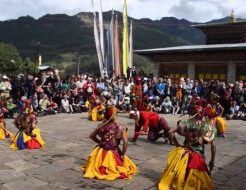
Bhutan Naked Festival 2024
The Jambay Lhakhang, situated in Bumthang and en route to the Kurjie Lhakhang, is the venue for…
Start Date: 15th November 2024
End Date: 18th November 2024
Destination: Jambay Lhakhang, Choekhor, Bumthang
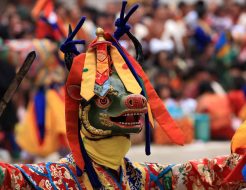
Bhutan Thimphu Festival Tour 2024
One of the biggest festivals in the country is the Thimphu Tshechu. This Thimphu festival tour is…
Start Date: 13th Sept 2024
End Date: 15th Sept 2024
Destination: Tashi Chhodzong, Thimphu
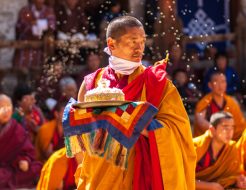
Punakha Festival Tshechu 2024
Punakha, situated in the western part of Bhutan, serves as the winter residence of the Je Khenpo,…
Start Date: 19th - February 2024
End Date: 21st February 2024
Destination: Punakha Dzong
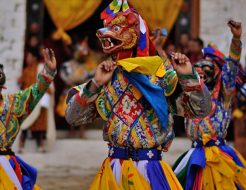
Paro Bhutan Festival 2024
The Paro Festival, an annual event held every spring, stands as one of the most vibrant and…
Start Date: 21st March, 2024
End Date: 25th March, 2024
Destination: Rinpung Dzong, Paro
CONTACT US
- homeThimphu, Bhutan
- emailbookbhutantour@gmail.com
- emailinfo@bhutantouragency.com
- +975-17614054
- +975-02-340662
- +975-17614054
- rdtamang





